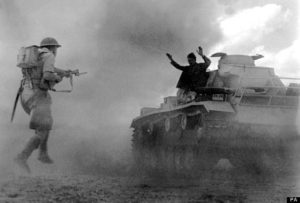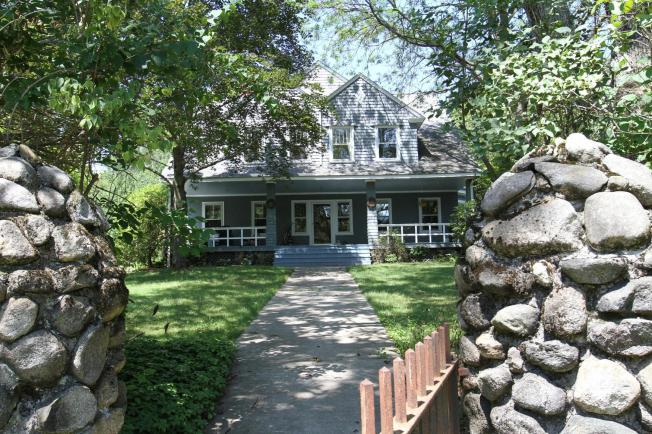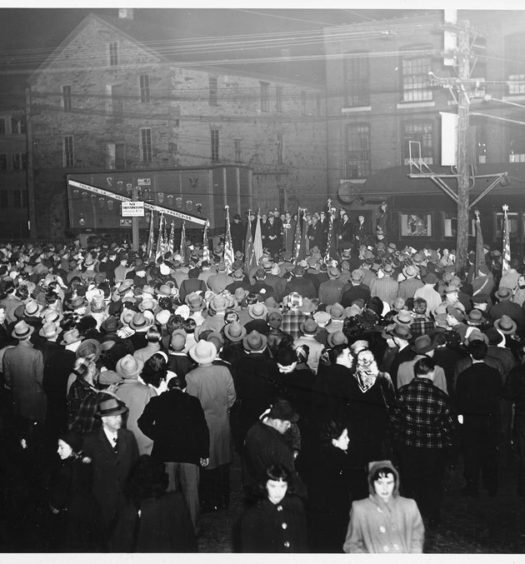They say that truth is stranger than fiction. This story seems to bear that out.
In 1940 with World War II approaching, the Federal Communications Commission (FCC) sent its staff over the entire United States to find locations suited to set up secret radio listening posts. These stations were to be part of the war effort and were intended to pick up German spies as well as distress signals and other signals of interest. All the information received was forwarded to the Pentagon. The program was top secret with various cover stories told to the local public. Thirteen such stations were built.
Thomas B. Cave, a top agent of the FCC from Boston, was assigned to select an area for a listening post in Rhode Island and after selecting a site in Greenville he abandoned it in favor of a 138-acre farm on Darby Road in Scituate. It was called the Suddard farm after the family who lived there and was on Chopmist Hill. The FCC proceeded to rent the property from the Suddard’s and Thomas Cave outfitted the site with a wide array of radios and transmitters. It took sixteen miles of wire to construct antennas in a variety of styles. The two directional antennas that were constructed could be rotated to receive a maximum signal; this process not only improved reception but could determine the exact compass bearing of the transmitter. Once the bearing was established a second station could tune in on that exact frequency and also obtain a compass bearing to the transmitter. From this information the position of the transmitter could be plotted.
As these stations began to come on line nationwide the officials in Rhode Island were in for a surprise. It turned out that the station on Chopmist Hill in Scituate was far more sensitive and able to pull in radio signals than any other stations. This ability was to produce many benefits to the U.S. war effort and save Allied lives.
During a test of the various stations a transmitter was taken to the Pentagon in Washington, DC and a wire antenna was lowered out of a window. A signal was then sent to simulate a German spy. The point was to find out how long it would take for the listening stations to detect and report on the signals. The Rhode Island station had the best response, responding in seven minutes with not only the content of the message but the location of the transmitter.
During wartime, weather is very important and the Germans chose frequencies for weather forecasts that could not be received in England. Those same signals were, however, received in Scituate and were forwarded to the European Command Headquarters. This task alone was an important advantage for the Allies.
In early 1942, one operator at Chopmist Hill was really surprised by one set of transmissions he picked up. They were quick exchanges among several persons speaking German. The operator could not speak the language, but he had some of the transmissions recorded onto a 12-inch coated aluminum disc. Intelligence experts at the Navy command base in Newport confirmed that the operator had picked up orders from the German high command in North Africa to its tanks fighting there. What a coup for Allied intelligence! After more listening at Chopmist Hill, even tank-to-tank transmissions were picked up. The signals were quickly forwarded by American intelligence to British forces fighting in this area, again resulting in a huge advantage for the Allies. When General Erwin Rommel, known as the “Desert Fox,” attempted to surround the British 8th Army at El Alemin, General Bernard Montgomery’s troops were waiting for him, having been forewarned by intelligence received from Chopmist Hill. All during the Battle of El Alamein, fought in Egypt in July 1942, which ended in a crucial Allied victory, Thomas Cave kept calling the Narragansett Electric Company to send crews to Chopmist Hill to move antenna poles in order to improve reception.

Communications from General Rommel’s Afrika Korps intercepted at Chopmist Hill helped a British army defeat the German army at the Battle of El Alamein in the fall of 1942.
In war drama is often played out in strange ways. This was the case as the Queen Mary steamed south to Cape Horn in transit from Rio de Janeiro to Australia. On board were 14,000 Allied troops. What those troops never knew was that German spies in Brazil had obtained the route of the ship, and as it proceeded south, reported the route to German intelligence in their homeland, leading to the dispatch of German U-boat submarines to steam to and wait along the ship’s path. Of all the U.S. listening stations only one, Chopmist Hill in Scituate, was able to tease out the tiny signals from the German spies reporting the path of the great vessel. Needless to say the Queen Mary’s route was secretly changed and the ship still exists today in Long Beach, California, where it is in the process of becoming a tourist attraction.
One of the risks taken by U.S. Navy pilots in World War II was the possibility of becoming lost over the ocean. With a constantly dwindling fuel supply the prospect of not knowing one’s location or which way to find land made survivability disturbingly uncertain. On many occasions Chopmist Hill picked up “mayday” signals from aircraft unsure of their location. One plane off the coast of Florida was guided to safety after Navy officials plotted the plane’s location, using the information gleaned from Chopmist Hill, and transmitting a compass course to guide the lost pilot to safety. Those aboard this particular airplane included actress Kay Francis who had just performed for U.S. troops.
One plane, with twenty-two military wounded aboard, was forced down over Labrador, Canada. Its signal was heard by the Scituate operators and search planes were dispatched. This mission became very difficult because the position was so close to the North Pole that the magnetic compass was rendered ineffective. The rescue planes had to rely on radio stations to keep from getting lost themselves, but after a three-week effort the site was located and the crew and wounded passengers rescued.
Chopmist Hill’s direction finding efforts had a devastating effect on German submarines; in many cases the Rhode Islanders working at Scituate felt they were actually “in on the kill,” as they worked back and forth with planes and surface ships to eliminate submarines in coastal areas.
Even Japanese balloons carrying explosives released into the jet-stream to follow it to the West Coast of the United States could not avoid Chopmist Hill. Many times the Scituate operators detected signals and reported them to the U.S. Army, which then dispatched war planes to shoot the balloons down.

Communications from German U-boats intercepted at Chopmist Hill helped to save the converted British troop carrier Queen Mary from enemy torpedoes
Reportedly, one of the reasons there was almost no sabotage inside the United States during the war was that Chopmist Hill was able to pick up and pinpoint the location of every radio transmitter that German agents set up.
Over and over again one phrase was repeated by Pentagon officials about the endless data that kept coming in. “We want it from Scituate. we don’t want it from any place other than Scituate.”
After the end of the war the Providence Journal printed many articles on Chopmist Hill. This was the time of the formation of the United Nations and perhaps it was these articles that led to Scituate being given very serious consideration as the site for the new United Nations headquarters. What was desired was a site close to either New York City or Boston that met various criteria. These included a minimum number of people displaced, a large area that could be developed, proximity to roads and rail transportation to both Boston and New York, and a site for a new airport. Scituate not only met all these criteria but also offered the advantage of excellent radio transmissions as its role during the war had proved. An irrepressible Scituate resident named George Matteson persuaded the Town Council to offer the Chopmist Hill site to the United Nations.
A United Nations delegation was sent out to view the different proposed U.S. sites, headed by Dr. Stoyan Gavrilovic of Yugoslavia. The delegates hiked up the Chopmist Hill watch tower (735 feet high), but the steps had to be sanded due to the ice. “The site meets most of the technical points,” Dr. Gavrilovic told the press on Chopmist Hill on January 23, 1946. He noted that miles of woodland offered ample room for an airport and large buildings. The other members of the delegation agreed that it was “one of the top sites yet seen in New England and probably in the United States for the site of the capital of the modem world”—the permanent headquarters of the United Nations. The Providence Journal headline informed its readers that Scituate was rated as one of the top potential locations for the United Nations.
Shortly thereafter, John D. Rockefeller, Jr. made a gift of $8.5 million to be used to buy a sixteen-acre lot of land on the East River in Manhattan. This is where the United Nations was built and the hesitation about being located in a large city was forgotten.
It is not clear what made Chopmist Hill so much more successful in picking up far way enemy transmissions than other U.S. listening stations. Some thought it was the result of unique geological formulations underground, but that was discounted by a propagation expert, who called the claim “quaint but preposterous.” Another theory, a propagation phenomenon called ducting, was advanced, but not to the satisfaction of all experts. Thomas Cave admitted shortly before his death in 1983 that it was not any super-receptivity of the Chopmist Hill site that carved its place in history, but instead was the advanced and top-secret radio equipment used there. But it would appear that the Chopmist Hill used equipment that was the same or similar to that used by other listening posts. Lacking the ability to investigate Chopmist Hill during World War II using modern scientific techniques, it will probably never be known what qualities, or combination of them, that made the Chopmist Hill listening site so unique and effective.
[Banner image: A recent photograph of the Suddard farmhouse, where the listening post at Chopmist Hill was located in World War II, now privately owned]
Bibliography:
Providence Sunday Journal Magazine, Dec. 6, 1981
Providence Journal, Nov. 23, 1945; April 21, 1983; Jan. 24, 1946; Feb. 11, 1946; Feb. 21, 1951
Barbara Sarkesian, ”Chopmist Hill and the United Nations,” at quahog.org (http://quahog.org/factsfolklore/index.php?id=5)
Paul Eno, “How Rhode Island Almost Became the Center of the World,” Yankee Magazine (Jan. 1986), 112.
Tom Kneitel, “CB’s Secret Wartime Mission, The Day They Heard Nazi Panzers on 11-Meters!,” CB Radio (Feb. 1978), 20-24.


























